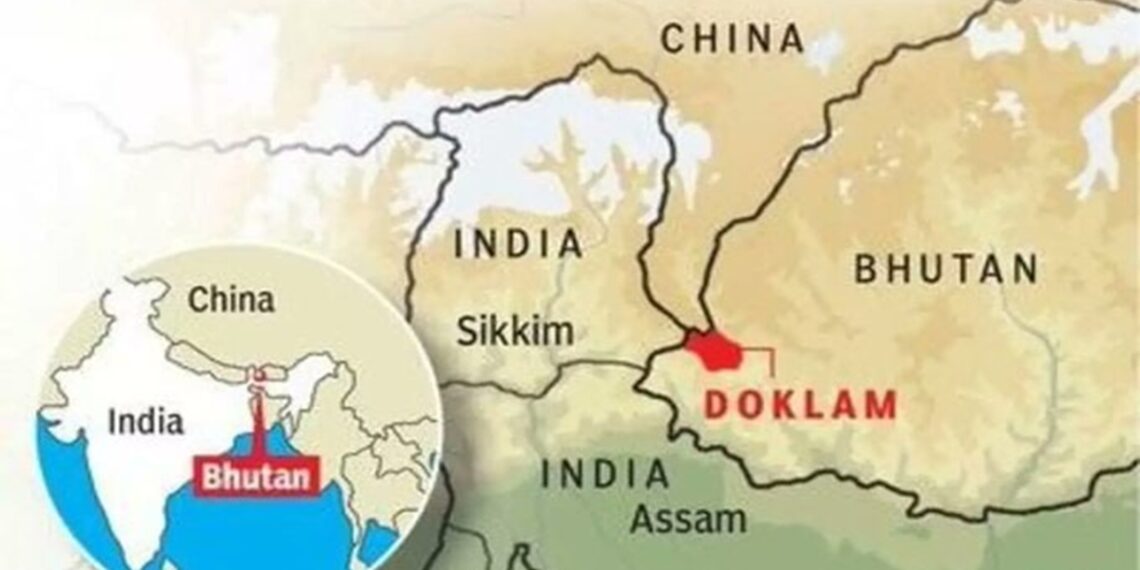A lot has been spoken and written about the India-China boundary issue since the incidents of Doklam and Galwan took place. Indeed, the scrutiny of the fourth estate has largely been on these two sectors.
The eastern sector, which is the most contentious, hardly ever finds its way into the national media.
One of the reasons for the “disregard” is the relative quietude that reigns in the sector, the credit for which must go to the military leadership of the man in command, i.e., the General Officer Commanding (GOC) of the Indian army’s 3 Corps.
However, it is not as if there have not been any issues in the Eastern Sector. Yangtse, which comes under the Tezpur-based 4 Corps, was one occasion when the Chinese sought to occupy the high ground.
But as I had written in an earlier column, the Bravehearts of the Indian Army made the Chinese beat a hasty retreat.
There is a sub-sector to the Far East in Rest-of-Arunachal Pradesh (RALP) which comes under 3 Corps.
It is the Walong sector which is located around 30 km south of the India-China border in Arunachal Pradesh near a village called Kibithu. Kahao—the easternmost village of India—is located to the east of Kibithu.
Lohit River, later known as the Kamlang River and finally, the Brahmaputra, enters Arunachal Pradesh near Kibithu and flows in a southerly direction.
The border with China runs from west to east slightly ahead of Kibithu along the Dichu River. The high ridges on either side of the river are held by the Indian Army virtually making it impossible for any ingress by the Chinese PLA.
The alignment of the boundary around this area is however disputed in the sense that there is a difference of interpretation about the exact alignment of the boundary.
McMahon’s thick nib pen and his haste to draw a boundary without proper survey are the reason for much of the border ails between the two Asian giants.
Just ahead of the Dichu River is a place called the Madan Ridge dominating both the Dichu River and an area north of the ridge.
In the perception of India, the alignment of the boundary runs along the crest of the Madan ridge.
However, the Chinese consider Madan Ridge as part of their territory for the obvious reason that any movement up to the Madan Ridge by the PLA from the north will not be noticed except from Indian posts located on top of the ridges on either side of the Lohit River.
Therefore, should the Chinese interpretation of the alignment be accepted, it would mean that the PLA would have an unhindered run right up to the Madan Ridge.
Even though this might not assure the PLA a permitted free run further south, holding on to a higher ridge will be of tremendous military advantage to the PLA.
On the other hand, the holding of the Madan ridge by the Indian Army along with the ridges on either side of the Lohit River will tilt the balance of defensive posture towards India.
However, for some reason or the other— perhaps simply not to up the ante— the Indian Army’s movement up to the south of the Dichu River is restricted, leaving the Madan Ridge to the PLA.
The PLA routinely visits Madan Ridge to assert their claim, leaving in the process “tell-tale signs”. I had over a decade ago climbed to the Dichu Observation Post.
The trek was an imaginably arduous one, especially as I have metallic implants on my right leg, a result of an almost fatal fall in an Indian army battalion while undertaking what is known as “slithering” in army parlance.
The slender rope could not cope with either my awkward weight or my ego. I thought I was still back in 1977, and was an 11-year-old cadet in the Rashtriya Indian Military College (RIMC), Dehra Dun.
Having been fit as a fiddle—indeed, the only cadet who could swiftly engage “first-class ropes” besides being the Best Scientific Boxer, ace gymnast and sprinter—it had bewildered me when I was declared medically unfit in Bhopal after having successfully cleared both the written (UPSC) examination and the Services Selection Board.
The reason was a hilarious hypertension. I was a no-gooder in academics, but when it came to aspects that tested my brawn and lithe limbs, I was overwhelmed.
It surprises my RIMC batchmates and juniors when they see me overweight and short of breath. But such is the way of life.
Today I want to concentrate on a controversial terminology which is termed as “limits of patrolling” in Indian Army parlance. Indeed, it has been the proverbial gripe for the noble force.
The “limits of patrolling” are determined by the “China Study Group”, of which the Indian Foreign Secretary used to be the chairman. But after the Galwan event, it has been understood that the National Security Adviser has taken over as the head of this important group.
But most people who have some familiarity with India-China boundary relations question why the “Group” disallows Indian Army patrolling to be undertaken in the general area of Madan Ridge, and perhaps even elsewhere along the 3,488 km long Line of Actual Control (LAC).
The most expedient riposte is that it might “up the ante” where the Indian army patrols to “cross” into what the Chinese perceive as their territory.
China has, of course, been continually accusing India of deploying troops in areas which are perceived as sensitive “ground of both vital and tactical importance”.
The Doklam crisis brought the apprehension out into the open. The attempt by the Chinese to construct a road to the Jampheri Ridge would have threatened the Siliguri Corridor.
Indeed, were it not for an alert Indian army, the PLA would have crossed the Torsa Nullah, an incident which would have been tantamount to war.
The people of India constantly fed by the probing media are aware of the peril, and the crisis was averted. But the Madan Ridge, which is as crucial, has never found suitable mention in mainstream media.
The 1962 war was a debacle. India was not prepared and a war was lost as a result. The “Battle of Walong” is one such story.
The Indians fought very well in the area and there was a great loss to the PLA in what is known as the “Tiger’s Mouth”. Four hundred Chinese soldiers died in the Namti Defences in what is euphemistically called the “Tiger’s Mouth”.
On 13-14 November 2024, a group of Indian armed forces veterans visited the site and paid homage to the martyrs of the war on “Walong Day”.
The Governor of Arunachal Pradesh, Lt Gen (Retd) K.T. Parnaik and the GOC of 3 Corps, Lt Gen. Abhijit S. Pendharkar were present on the solemn occasion.
In any event, the Madan ridge is one of the areas China claims. In fact, the ridge is important for both armies.
While the Indian Army has stopped patrolling in the general area of Madan Ridge, it is well entrenched in guarding a possible approach by the Chinese and it is ensured that 1962 will not be repeated.
What however will happen in the event of an outbreak of a full-fledged conflict is a matter of military exigency and one does not have an insight into such a plan.
But the fact of the matter is that the villagers who reside in the remotest of hamlets right on the border are very friendly and are emotionally attached to the Indian Army in the sector.
Kahao, a quaint little village, is one such village which is one of the first places in India to witness the sunrise.
The inhabitants of the village are called Meyors and they are a very friendly lot. I had stopped in the village for a mug of village brew on my way up to the Dichu Observation Post.
However, the question which crossed one’s mind (at the time when I visited the area) is why the powers that be in India had not constructed a proper, concrete bridge in place of the Foot Suspension Bridge over the Lohit.
After all, it was rather strange that only one person could go across the swirling overpass at a time. What would happen in an emergency or were the PLA to catch the Indian side by surprise?
The strange rationale, it was informed, was that it is better to keep the Indian border areas inaccessible in order not to give a free run to an invading enemy.
Further, better connectivity also entails creating additional logistical infrastructures. All of which come at a cost. So was the case in the Walong sector.
In Kibithu, the suspension bridge over the Lohit River is the only connectivity from west to east.
Lack or lack of reliance on connectivity between two localities separated by a water obstacle creates a sense of unfounded fear among the troops and it will be the general tendency to pull back the troops under a secure wing at the earliest opportunity.
It was probably the reason why the Indian Army pulled back prematurely in 1962.
However, good sense has prevailed and a new bridge has come up further south of the suspension bridge near a village called Messaih.
This bridge is motorable and is hidden from enemy observation and out of direct firing range.
The Indian Army is presently better poised to face a situation if the enemy were to destroy the old bridge called FSB 17 and isolate the troops on the Eastern bank of the river from those on the Western bank.
The long and short of it is that much development has happened in the Eastern Sector during the last couple of years.
It has been fortified with new axes (although robust laterals are probably yet to see the light of day) and even advanced landing grounds have come up near the LAC as a result of Exercise Gagan Shakti.
However, one aspect that needs to be looked into with utmost urgency is the widening and double-laning of the roads, especially in the Walong and the Subansiri sub-sectors. Inclement weather plays havoc every rainy season and traversing a road to an area such as Tuting is a harrowing experience.
The tragedy of 1962 happened because the realities were shrugged off. I have witnessed how the Indian army is presently fortified in the RALP.
I know that the PLA can never set foot on Indian soil ever again.
The military leadership in Rangapahar, I am certain, has seen to it. 1962 cannot happen again. I am also certain that “tactical gaps”—if they still exist—would be summarily addressed.















